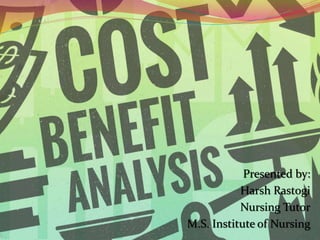
costbenefitanalysis-201224093003 (1).pdf
- 1. Presented by: Harsh Rastogi Nursing Tutor M.S. Institute of Nursing
- 2. Cost Cost is defined as the cash amount (or the cash equivalent) given up for an asset. Cost denotes the amount of money that a company spends on the creation or production of goods or services. This is the amount that the seller charges for a product, and it includes both the production cost and the mark-up, which is added by the seller in order to make a profit.
- 3. Cont… Any negative effect on an organization resulting from the implementation of the project. Example 1. Maintenancecosts 2.Environment 3.Research and development 4.Labour costs, etc.
- 4. Benefit Something that produces good or helpful results or effects or that promotes well-being A benefit is any positive effect on the organization resulting from the implementation of the project.
- 5. Cont… Example 1. Increase inproductivity 2. Reduction in costs 3. Saving time, Etc.
- 7. Definition Cost–benefit analysis (CBA), sometimes also called benefit–cost analysis, is a systematic approach to estimating the strengths and weaknesses of alternatives used to determine options which provide the best approach to achieving benefits while preserving savings (for example, in transactions, activities, and functional business requirements). CBA may be used to compare completed or potential courses of actions, or to estimate (or evaluate) the value against the cost of a decision, project, or policy.
- 8. Cont… An approach to make economic decisions of any kind. Economic evaluation technique that measures all the positive (benefits) and negative (cost) consequences of an intervention or programme in monetary terms. Or It is a process for evaluating the merits of a particular project in a systematic way in terms of cost & benefits of the project.
- 9. Applications of CBA CBA has two main applications: To determine if an investment (or decision) is sound, ascertaining if – and by how much – its benefits outweigh its costs. To provide a basis for comparing investments (or decisions), comparing the total expected cost of each option with its total expected benefits.
- 10. Concept Cost benefit is a tool which modern financial analysts adopt before undertaking any financial operation or commercial activity. The ultimate aimof a business organization is to make profits. Therefore,any system in the organization must produce more benefits as compared to its costs for the organization to survive & prosper.
- 11. Cont… A cost benefit analysis is done to determine how well, or how poorly, aplanned action will turn out. The analysis relies on the addition of positive factors and the subtraction of negative ones to determine a net result. CBAhas been established primarily as a tool for use by governments in making their social and economic decisions.
- 12. Cont… CBAmeasures costs and benefits to the community of adopting a particular course of action e.g. Community health services, adulteducation, etc. When investment made commensurate with the benefit derived, it can be said that operation is positive and viable; but when benefits derived do not compensate financial investments made, it can be said that it is financially non- viable and negative.
- 13. Cont… Most Benefit Analysis is used todetermine: Whether a solution/project is economicallyfeasible Which of two or more projects provides the best return oninvestment Other issues: Is the project worthwhile financially?
- 14. Principles of CBA Common unit of measurement Avoid double counting Valuation of human Study area Life particular
- 15. Steps of CBA Specifying the project clearly Describe quantitatively the inputsandoutputs of theprogramme Estimatethesocial costandbenefitof these inputs and outputs Comparethese benefits andcost
- 16. 1. Specifying the project clearly The first step is to decide on the perspective from which the study is tobe done. When we have decided on the perspective on the main elements of the projects such as, the study of the location, timing, group involved, the connection with other program, etc, should be considered.
- 17. 2. Describe inputs and outputs Forsome projects it is easy to identify the input and output. Fore.g. if we are planning a waste water treatment project, the staffs of that program will be able to provide a full physical specification of the plant, together with the inputs required to build it and keep it running. However, it is harder to predict the uncertainties caused bythe factors which were never in consideration before.
- 18. 3. Estimate the social cost and benefit The next step is to put values on input & output flows, i.e. to measure costs & benefits. We could do this in any units but in many cases we will be dealing with effects, especially on the benefit side that are not directly registered on market.
- 20. 4. Compare benefits & costs Next step is to make comparison between cost incurred andbenefit derived from the project. One of them is to subtract the total cost from the total benefit toget net benefit. (Total cost –Total benefit = Net benefit). If the net benefit is positive then the cost benefit is positive and ifthe net benefit is negative then the cost benefit is negative.